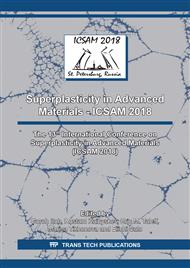[1]
S. Qu, X.H. An, H.J. Yang, C.X. Huang, G. Yang, Q.S. Zang, Z.G. Wang, S.D. Wu, Z.F. Zhang, Microstructural evolution and mechanical properties of Cu–Al alloys subjected to equal channel angular pressing, Acta Mater. 57 (2009) 1586-1601.
DOI: 10.1016/j.actamat.2008.12.002
Google Scholar
[2]
Y.H. Zhao, X.Z. Liao, Z. Horita, T.G. Langdon, Y.T. Zhu, Determining the optimal stacking fault energy for achieving high ductility in ultrafine - grained Cu–Zn alloys, Mater. Sci. Eng. A 493 (2008) 123-129.
DOI: 10.1016/j.msea.2007.11.074
Google Scholar
[3]
T. Ungar, L. Balogh, Y.T. Zhub, Z. Horita, C. Xud, T.G. Langdon, Using X-ray microdiffraction to determine grain sizes at selected positions in disks processed by high-pressure torsion, Mat. Sci. and Eng. A 444 (2007) 153–156.
DOI: 10.1016/j.msea.2006.08.059
Google Scholar
[4]
X.H. An, Q.Y. Lin, S.D. Wu, Z.F. Zhang, R.B. Figueiredo, N. Gaoc, T.G. Langdon, The influence of stacking fault energy on the mechanical properties of nanostructured Cu and Cu–Al alloys processed by high-pressure torsion, Scripta Materialia 64 (2011).
DOI: 10.1016/j.scriptamat.2011.01.041
Google Scholar
[5]
R.Z. Valiev, R.K. Islamgaliev, I.V. Alexandrov, Bulk nanostructured materials from severe plastic deformation, Prog. Mater. Sci. 45 (2000) 103-189.
DOI: 10.1016/s0079-6425(99)00007-9
Google Scholar
[6]
C.X. Huang, K. Wang, S.D. Wu, Z.F. Zhang, G.Y. Li, S.X. Li, Deformation twinning in polycrystalline copper at room temperature and low strain rate, Acta Mater. 54 (2006) 655-665.
DOI: 10.1016/j.actamat.2005.10.002
Google Scholar
[7]
L. Balogh, T. Ungar, Y.H. Zhao, Y.T. Zhu, Z. Horita, C. Xu, T.G. Langdon, Influence of stacking-fault energy on microstructural characteristics of ultrafine-grain copper and copper-zinc alloys, Acta Mater.56 (2008) 809-820.
DOI: 10.1016/j.actamat.2007.10.053
Google Scholar
[8]
Z.J. Zhang, Q.Q. Duan, X.H. An, S.D. Wu, G. Yang, Z.F. Zhang, Microstructure and mechanical properties of Cu and Cu-Zn alloys produced by equal channel angular pressing, Mat. Sci. and Eng. A 528 (2011) 4259-4267.
DOI: 10.1016/j.msea.2010.12.080
Google Scholar
[9]
P. Zhang, S.X. Li, Z.F. Zhang, General relationship between strength and hardness, Mat. Sci. and Eng. A 529 (2011) 62-73.
Google Scholar
[10]
P.Zhang, S.Qu, M.X. Yang, G.Yang, S.D.Wu, S.X.Li, Z.F. Zhang, Varying tensile fracture mechanisms of Cu and Cu–Zn alloys with reduced grain size: From necking to shearing instability, Mat. Sci. and Eng. A594 (2014) 309-320.
DOI: 10.1016/j.msea.2013.11.079
Google Scholar


